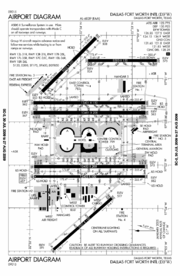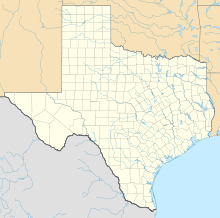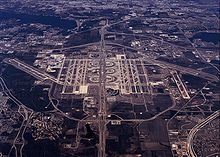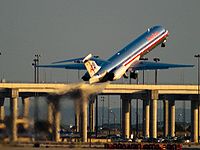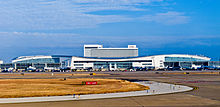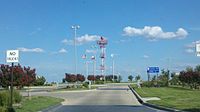- Dallas/Fort Worth International Airport
-
Dallas/Fort Worth International Airport 
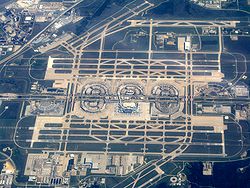
IATA: DFW – ICAO: KDFW – FAA LID: DFW Summary Airport type Public Owner City of Dallas City of Fort Worth
Operator DFW Airport Board Serves Dallas–Fort Worth Location Coppell, Euless, Grapevine, and Irving Hub for Elevation AMSL 607 ft / 185 m Coordinates 32°53′49″N 097°02′17″W / 32.89694°N 97.03806°WCoordinates: 32°53′49″N 097°02′17″W / 32.89694°N 97.03806°W Website Maps FAA airport diagram Location within Texas Runways Direction Length Surface ft m 13L/31R 9,000 2,743 Concrete 13R/31L 9,301 2,835 Concrete 17C/35C 13,401 4,085 Concrete 17L/35R 8,500 2,591 Concrete 17R/35L 13,401 4,085 Concrete 18L/36R 13,400 4,084 Concrete 18R/36L 13,400 4,084 Concrete Helipads Number Length Surface ft m H1 158 48 Concrete Statistics (2010) Passengers 56,906,610 (8th) (+1.6%) Aircraft operations 652,261 (4th) (+2.1%) Sources: Airports Council International[1][2] Dallas/Fort Worth International Airport (IATA: DFW, ICAO: KDFW, FAA LID: DFW) is located between the cities of Dallas and Fort Worth, Texas, and is the busiest airport in the U.S. state of Texas.[1] It generally serves the larger Dallas–Fort Worth metropolitan area, with carriers providing regional, national and international flights.
With 652,261 aircraft movements in 2010,[2] it is the fourth busiest airport in the world in terms of aircraft movements. In terms of passenger traffic, it is the eighth busiest airport in the world transporting 56,906,610 passengers[1] in 2010. It is the main hub and largest hub for American Airlines, as American Airlines has its headquarters in Fort Worth. DFW Airport is considered to be an Airport City.
In terms of land area, at 18,076 acres (7,315 ha),[3] it is the largest airport in Texas, and the second largest in the United States, behind Denver International Airport. It is the tenth busiest international gateway in the United States, and second in Texas, following Houston's George Bush Intercontinental Airport.[4]
In 2006 the airport was named the "Best Cargo Airport in the World" according to the second edition of a survey.[5][6]
The airport, within the incorporated cities of Coppell,[7] Euless,[8] Grapevine,[9] and Irving,[10] serves 144 domestic and 47 international destinations,[11] and is the largest and primary hub for American Airlines, and also the primary hub for American Eagle.
The airport is often referred to by its IATA airport code, "DFW." It is operated in many ways like a small city: it has its own post office, ZIP code, and public services. The United States Postal Service gave the airport its own city designation, DFW Airport, TX.[12] The members of the airport's Board of Directors are appointed by the "owner cities" of Dallas and Fort Worth. The airport is inside the city limits of four suburban cities, a situation that has led to legal battles over jurisdiction (see below). To help ensure future harmony with its neighbors, the DFW Airport Board includes a non-voting member — a representative chosen from the airport's neighbors (Irving, Euless, Grapevine, and Coppell) on a rotating basis.
Contents
History
As early as 1927, before the area had an airport, Dallas proposed a joint airport with Fort Worth. Fort Worth declined the offer, and thus the two cities opened their own airports, Love Field and Meacham Field. Both airports had scheduled airline service, with both fields being famous for their places in the events of November 22, 1963 before the assassination of President Kennedy. President Johnson took the oath of office on the tarmac at Love Field.[13]
In 1940, the Civil Aeronautics Administration earmarked $1.9 million for the construction of a Dallas/Fort Worth Regional Airport. American Airlines and Braniff Airways struck a deal with the city of Arlington to build an airport there, but the governments of Dallas and Fort Worth disagreed over its construction and the project was abandoned in 1942. After World War II, Fort Worth annexed the site and developed it into Amon Carter Field[14] with the help of American Airlines.
Fort Worth transferred its commercial flights from Meacham Field to the new airport in 1953, which was just now 12 miles (19 km) from Dallas Love Field.
In 1960, Fort Worth purchased Amon Carter Field and renamed it Greater Southwest International Airport GSW in an attempt to compete with Dallas' more successful airport. However, GSW's traffic continued to decline relative to Dallas Love Field. By the mid-1960s, Fort Worth was getting 1% of Texas air traffic while Dallas was getting 49%, which led to the virtual abandonment of GSW. The joint airport proposal was revisited in 1961 after the FAA refused to invest any more money in separate Dallas and Fort Worth airports. Although the Fort Worth airport was eventually abandoned, Dallas Love Field became congested and had no more room to expand. Following an order from the federal government in 1964 that they would unilaterally choose a site if both cities could not come to an agreement on a site, officials from the two cities finally agreed on a location for a new regional airport that was north of the abandoned GSW and almost perfectly equidistant from the two city centers. The land was purchased by both cities in 1966, and construction began in 1969.
The first landing of a supersonic BAC/Sud Aviation (now BAE Systems and Aerospatiale) Concorde in the United States occurred at DFW Airport in 1973 to commemorate the airport's completion. Concorde later served DFW from 1979–1980 in a cooperative agreement between Braniff Airways, British Airways, and Air France. Braniff ended the service due to low load factors. Braniff was the largest airline to open DFW in 1974 with a full semicircular terminal designated 2W ( now Terminal B) devoted to its operations. Other airlines, like American Airlines, only had half a terminal or less. DFW Airport opened for commercial service on January 13, 1974. The original name was Dallas/Fort Worth Regional Airport. The name change to Dallas/Fort Worth International did not occur until 1985. Following the Wright Amendment of 1979, which banned long-distance flights from Love Field, DFW became the only airport in the metropolitan area to offer long-haul commercial air passenger service on aircraft with more than 56 passenger seats.[15] American established its first hub at DFW on June 11, 1981,[16] adding flights to London in 1982, and Tokyo in 1987.[citation needed] American Airlines finished moving its headquarters from Grand Prairie, Texas to a building in Fort Worth located near DFW Airport on January 17, 1983; the airline began leasing the facility from the airport, which owns the facility.[17] Braniff International already had International service to South America and Mexico in 1974, London in 1978 and Europe and Asia in 1979. Delta Air Lines built up a hub at DFW during the same period but announced closure in 2004 in a restructuring of the airline to avoid bankruptcy. Today, Delta only flies from DFW to its 7 hubs.
After the closing of Delta's hub in 2005, DFW Airport offered incentives to Southwest Airlines to relocate its hub to DFW from Love Field. Southwest, like in the past, chose to stay at Love Field. In 1989, the airport authority announced plans to rebuild the existing terminals and construct 2 new runways. After an environmental impact study was released the following year, the cities of Irving, Euless, and Grapevine sued the airport over its extension plans, a battle that was finally decided (in favor of the airport) by the US Supreme Court in 1994. The seventh runway opened in 1996. The 4 primary North-South runways (those closest to the terminals) were all lengthened from 11,388 feet (3,471 m) to their current length of 13,400 feet (4,084 m). The first of these, 17R/35L, was extended in 1996 (at the same time the new runway was constructed), and the other three (17C/35C, 18L/36R, and 18R/36L) were extended in 2005. DFW is now the only airport in the world with 4 serviceable paved runways longer than 4,000 metres (13,123 ft).
Terminal D, built for international service operations, and Skylink, a modern people mover system, opened in 2005.[18][19]
DFW is one of two airports in the US, the other being Hartsfield-Jackson Atlanta International Airport, to receive US troops from Iraq and Afghanistan for rest and recuperation.[citation needed]
Terminals
Dallas/Fort Worth International Airport has five terminals. The airport is designed with expansion in mind, and can theoretically accommodate up to thirteen terminals totaling 260 gates, although this level of expansion is unlikely to be reached in the foreseeable future.
The terminals at DFW are semicircular (except for the newest terminal, Terminal D, which is a "square U" shape) and built around the airport's central north-south arterial road, Spur 97, also known as "International Parkway." Until the late 1990s, they were designated by a number (2 being northernmost, 4 being southernmost) and a letter suffix ("E" for East, "W" for West). This system was later scrapped, and the terminals are now lettered from A to E. Terminals A, C, and E (from north to south) are on the east side of the airport, while Terminals B and D (from north to south) are on the west side.
DFW's terminals are designed to minimize the distance between a passenger's car and airplane as well as reduce traffic around terminals. A consequence of this layout is that connecting passengers had to walk extremely long distances between gates (in order to walk from one end of the semicircular concourse to the other, one must walk the entire length; there were no shortcuts between the ends). The original people mover train (Airtrans APM) which opened with the airport was notoriously slow (17 mph (27 km/h)), uni-directional (running only in a counter-clockwise direction), and was located outside the secured area (thus requiring travelers to go through the security process again). It was replaced by SkyLink in April 2005 after serving approximately 250 million passengers.[20] Skylink serves all five terminals at a considerably higher speed (up to 35 mph (56 km/h)), is bi-directional, and is located inside the secured area.[19]
DFW Airport is undergoing a $1.9 billion "Terminal Renewal and Improvement Program" (TRIP), which encompasses renovations of Terminals A, B, C and E. Work on the project began following the conclusion of Super Bowl XLV in February. Terminal A will be the first terminal completed sometime in 2014, and the entire TRIP project should be complete by the end of 2017.[21]
Terminal A
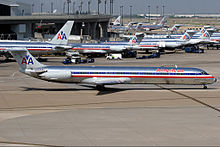 Numerous American Airlines aircraft at the airport in 2005
Numerous American Airlines aircraft at the airport in 2005
American Airlines and its regional affiliate American Eagle have a large presence at Dallas/Fort Worth. The world's fourth largest airline, in terms of passengers transported, operates its largest hub at DFW. The two airlines operate at four of the five terminals at the airport. Terminal A, previously called "Terminal 2E" when the airport was first opened, is fully occupied by American Airlines for domestic flights. Prior to the opening of Terminal D, Terminal A operated most of AA's international flights at the airport. During the late 1990s, a significant number of American Eagle flights moved to Terminal B. Also in the late 1990s, American Eagle built a Satellite Terminal (Named Satellite Terminal A2) due to the lack of aircraft gates. It was located near Terminal A and was only accessible via shuttle buses. Satellite Terminal A2 (Gates A2A–A2N) was abandoned in 2005 when American Eagle moved all operations to Terminals B and D.
Terminal A has 31 gates: A9–A26, A28–A29, A33–A39
Terminal B
This terminal was originally called "Terminal 2W" when the airport first opened. It was formerly occupied by Braniff International Airways which was the largest carrier to open DFW in 1974. Braniff Airways was its main occupant until May 1982. An "Inter-Faith" Chapel near United's former gates commemorates the airline. American Eagle occupies 32 gates at Terminal B. Midwest Airlines, US Airways, and United Airlines relocated to Terminal B in July 2006. That all changed on December 13, 2009 when United moved to Terminal E to join its new Alliance partner – Continental. At that point American Eagle was the sole operator in Terminals B. Prior to the opening of Terminal D, all non-AA international flights operated from this terminal.
Terminal B has 35 gates: B3–B30, B33–B39
Terminal C
American Airlines operates all the gates at Terminal C, originally called "Terminal 3E" for only domestic flights.
Terminal C has 31 gates: C2–C4, C6–C8, C10–C12, C14–C17, C19–C22, C24–C33, C35–C37, C39
International Terminal D
International Terminal D is a 2,000,000 sq ft (186,000 m2) facility capable of handling 32,000 passengers daily or 11.7 million passengers annually. The terminal features 200 ticketing positions and a federal inspection facility capable of processing 2,800 passengers per hour. The concession areas consist of 100,000 sq ft (9,290 m2) of retail, including many dining and retail options. Stores include Mont Blanc, La Bodega Wines, Brookstone, L'Occitane and many others. The terminal was designed by HKS, HNTB and Corgan Associates, with Austin Commercial serving as Construction Manager at Risk, and opened in July 2005.
The 298-room Grand Hyatt DFW Hotel is directly connected to the terminal. Under the Airport Access Authorization to Commercial Establishments Beyond the Screen Checkpoint (AAACE) program, overnight guests at the hotel who are not flying can obtain a pass to enter the concourses to visit shops and restaurants, subject to screening by a law enforcement officer and an identity check against the government's no-fly list. Detroit Metropolitan Wayne County Airport is the only other airport participating in this program.[22]
The eight-level parking garage has over 8,100 parking spaces and uses a Smart Technology System that lets guests know which floors are full. Air-conditioned skybridges with moving walkways and elevators connect the garage to the terminal, and an arrivals canopy roof shields pedestrians from inclement weather as they enter and exit the terminal.
Terminal D has 29 gates: D6–D8, D10–D12, D14–D18, D20–D25, D27–D31, D33–D34, D36–D40.
Terminal E
Terminal E, originally called Terminal 4E, was occupied primarily by Delta Air Lines until Delta closed its hub in 2005 and retained only flights to its other hubs. Delta branded the terminal "Easy Street" and marketed this term to passengers.[23] Terminal E is distinctive in that it has a satellite terminal connected by an underground walkway. The satellite, previously used by Delta and later used by Delta Connection carriers, is currently unused. Terminal E is also connected to other terminals only by Skylink and is lacking the walkways that link other terminals.
Terminal E has 26 gates: E2, E4–E18, E20–E21, E31–E38. It has customs facilities that were used when Delta operated flights to Frankfurt in the early 1990s, and when Air France and Aeroméxico used to serve DFW before the International Terminal D was constructed. In the 2000s, SkyTeam partner airlines Continental and Northwest moved to gates adjacent to Delta.
Airlines and destinations
Airlines Destinations Terminal Air Canada Express operated by
Jazz AirToronto-Pearson D Alaska Airlines Seattle/Tacoma E American Airlines Albuquerque, Atlanta, Austin, Baltimore, Birmingham (AL), Boston, Burbank, Charlotte, Chicago-O'Hare, Cleveland, Colorado Springs, Columbus (OH), Dayton, Denver, Detroit, El Paso, Fayetteville (AR), Fort Lauderdale, Fort Myers, Fresno, Hartford, Honolulu, Houston-Intercontinental, Huntsville, Indianapolis, Jacksonville, Kahului, Kansas City, Las Vegas, Little Rock, Los Angeles, Louisville, McAllen, Memphis, Miami, Minneapolis/St. Paul, Nashville, New Orleans, New York-JFK, New York-LaGuardia, Newark, Norfolk, Oklahoma City, Omaha, Ontario, Orange County, Orlando, Palm Springs, Philadelphia, Phoenix, Pittsburgh, Portland (OR), Raleigh/Durham, Reno/Tahoe, Richmond, Sacramento, St. Louis, Salt Lake City, San Antonio, San Diego, San Francisco, San Jose (CA), San Juan, Seattle/Tacoma, Tampa, Tucson, Tulsa, Washington-Dulles, Washington-National, West Palm Beach, Wichita
Seasonal: Anchorage, Eagle/Vail, Hayden/Steamboat Springs, Jackson Hole, MontroseA, C, D American Airlines Bridgetown, Belize City, Buenos Aires-Ezeiza, Calgary, Cancún, Caracas, Cozumel, Frankfurt, Guadalajara, Guatemala City, Liberia (CR), London-Heathrow, Madrid, Mexico City, Monterrey, Montréal-Trudeau, Paris-Charles de Gaulle, Puerto Vallarta/Riviera Nayarit, Rio de Janeiro-Galeão, San José (CR), San José del Cabo, San Salvador, Santiago de Chile, São Paulo-Guarulhos, Tokyo-Narita, Toronto-Pearson, Vancouver
Seasonal: Acapulco, Ixtapa/Zihuatanejo, Montego Bay, Nassau, Panama City, ProvidencialesD American Eagle Abilene, Alexandria, Amarillo, Augusta (GA), Baton Rouge, Bloomington/Normal, Brownsville, Cedar Rapids, Champaign/Urbana, Charleston (SC), Chattanooga, Cheyenne, Cincinnati/Northern Kentucky, College Station, Columbia (SC), Columbus (GA), Corpus Christi, Dayton, Des Moines, Durango, Evansville, Fayetteville (AR), Fayetteville (NC), Fort Smith, Fort Walton Beach, Fort Wayne, Grand Island, Grand Junction, Grand Rapids, Greensboro (NC), Greenville (SC), Gulfport/Biloxi, Houston-Hobby, Jackson, Knoxville, Lafayette, Lake Charles, Laredo, Lexington, Little Rock, Louisville, Lubbock, Madison, Manhattan (KS), McAllen, Midland-Odessa, Milwaukee, Mobile, Moline/Quad Cities, Montgomery, Pensacola, Peoria, Rapid City (SD), Roswell, Santa Fe, Savannah, Sioux Falls, Springfield (IL), Springfield (MO), Tallahassee, Texarkana, Tulsa, Tyler, Waco
Seasonal: Asheville, Aspen [begins December 15], Gunnison/Crested Butte, Montrose, Myrtle BeachB, D American Eagle Aguascalientes, Chihuahua, Guadalajara, León/El Bajio, Mazatlán, Morelia, Queretaro, San Luis Potosí, Torreón/Gómez Palacio, Veracruz D American Eagle operated by
Executive AirlinesCollege Station, Fort Smith, Joplin, Killeen, Lawton, Longview, Monroe, San Angelo, Shreveport, Texarkana, Tyler, Waco, Wichita Falls B British Airways London-Heathrow D Continental Airlines Houston-Intercontinental, Newark E Continental Connection operated by Colgan Air Houston-Intercontinental E Continental Express operated by
ExpressJet AirlinesCleveland, Houston-Intercontinental E Delta Air Lines Atlanta, Detroit, Minneapolis/St. Paul
Seasonal: Salt Lake CityE Delta Connection operated by
Atlantic Southeast AirlinesCincinnati/Northern Kentucky, Detroit, Memphis, Minneapolis/ St. Paul E Delta Connection operated by
ComairCincinnati/Northern Kentucky, Memphis, Minneapolis/St. Paul E Delta Connection operated by
Compass AirlinesDetroit, Minneapolis/St. Paul E Delta Connection operated by
Mesaba AirlinesDetroit, Minneapolis/St. Paul, New York-JFK, Salt Lake City E Delta Connection operated by
Pinnacle AirlinesMemphis E Delta Connection operated by
SkyWest AirlinesMinneapolis/St. Paul, Salt Lake City E Emirates Dubai [begins February 2][24] D Frontier Airlines Denver E Frontier Airlines operated by
Republic AirlinesDenver, Milwaukee E KLM Seasonal: Amsterdam[25] D Korean Air Seoul-Incheon D Lufthansa Frankfurt D Qantas Brisbane1, Sydney D Spirit Airlines Chicago-O'Hare, Fort Lauderdale, Las Vegas E Sun Country Airlines Cancún, Minneapolis/St. Paul
Seasonal: Cozumel, Punta CanaD TACA Airlines San Salvador D United Airlines Chicago-O'Hare, Denver, San Francisco, Washington-Dulles E United Express operated by
Mesa AirlinesChicago O'Hare, Washington-Dulles E United Express operated by
Shuttle AmericaChicago-O'Hare, Denver, Washington-Dulles E United Express operated by
SkyWest AirlinesChicago-O'Hare, Houston-Intercontinental, Los Angeles, San Francisco E US Airways Charlotte, Las Vegas [ends November 29] , Philadelphia, Phoenix E US Airways Express operated by Republic Airlines Philadelphia, Washington-National E Virgin America Los Angeles, San Francisco E ^1 Qantas has no direct service from Brisbane to Dallas. The only direct or non-stop service is from Dallas to Brisbane
Statistics
Top destinations
Busiest International Routes Out of Dallas/Fort Worth International Airport (2010)[26] Rank City Passengers Top Carriers 1  Cancun, Mexico
Cancun, Mexico416,401 American, Sun Country 2  London (Heathrow), United Kingdom
London (Heathrow), United Kingdom328,772 American, British Airways 3  Mexico City, Mexico
Mexico City, Mexico309,015 American 4  Tokyo (Narita), Japan
Tokyo (Narita), Japan265,058 American 5  Frankfurt, Germany
Frankfurt, Germany202,953 American, Lufthansa 6  Paris (Charles de Gaulle), France
Paris (Charles de Gaulle), France202,949 American 7  Toronto, Canada
Toronto, Canada178,554 Air Canada, American 8  Puerto Vallarta, Mexico
Puerto Vallarta, Mexico168,553 American 9  Monterrey, Mexico
Monterrey, Mexico157,417 American 10  San Jose de Cabo, Mexico
San Jose de Cabo, Mexico153,612 American Busiest Domestic Routes from DFW (September 2010 - August 2011)[27] Rank City Passengers Carriers 1  Atlanta, GA
Atlanta, GA1,062,000 AirTran, American, Delta 2  Los Angeles, CA
Los Angeles, CA1,003,000 American, United, Virgin America 3  Chicago, IL (ORD)
Chicago, IL (ORD)882,000 American, Spirit, United 4  Denver, CO
Denver, CO733,000 American, Frontier, United 5  San Francisco, CA
San Francisco, CA610,000 American, United, Virgin America 6  Las Vegas, NV
Las Vegas, NV600,000 American, Spirit, US Airways 7  Phoenix, AZ
Phoenix, AZ595,000 American, US Airways 8  San Antonio, TX
San Antonio, TX591,000 American 9  Austin, TX
Austin, TX573,000 American 10  Miami, FL
Miami, FL544,000 American Cargo
With 578,906 tons of cargo handled in 2009, DFW is the world's 29th busiest cargo airport.[28] Dallas/Fort Worth International Airport handles sixty percent of all air cargo in Texas. Asia and Europe account for over 75% of the cargo at the 29th busiest cargo airport in the world. [citation needed]
In a recent survey by Air Cargo World, Dallas/Fort Worth ranked as "The Best Cargo Airport in the World". Frankfurt International Airport came in second, while Hong Kong International Airport and the world's busiest cargo airport, Memphis International Airport, tied for third.[1]
Cargo carriers
- ABX Air
- Air China Cargo
- Air Transport International
- Ameriflight
- BAX Global
- Cathay Pacific Cargo
- China Airlines Cargo
- China Cargo Airlines
- EVA Air Cargo
- FedEx Express
- Korean Air Cargo
- Lufthansa Cargo
- Martinaire
- Qantas Freight
- Singapore Airlines Cargo
- Southern Air
- UPS Airlines
Ground transportation
Within airport
- The current people mover system, named Skylink, opened on May 21, 2005 and is the world's largest high-speed airport train system. Totally automated, Skylink trains run every two minutes,[29] and travel at speeds up to 35 mph (56 km/h). Skylink is double-tracked, permitting bi-directional operations. The Skylink system was acquired from Bombardier Transportation and connects all terminals on the secure side.
Skylink replaced the original Airtrans system (part of which was later operated as American Airlines' TrAAin System), a state-of-the-art people mover at the time of the airport's opening. It served the airport for 31 years from 1974–2005 and transported a quarter of a billion passengers between DFW's four terminals and employee facilities, logging a total of 97,000,000 miles (156,000,000 km) on its fleet. Over time, its top speed of 17 mph (27 km/h) and uni-directional guideway made it impractical for connecting passenger transfers. The system was decommissioned soon after Skylink opened as a modern replacement; the old guideways were left in place throughout the airport.[20]
- Terminal Link connects all terminals with a shuttle bus system on the non-secure side.[30]
To and from airport
- DFW is served by the Trinity Railway Express commuter rail line at CentrePort/DFW Airport Station, south of the airport. The line serves both downtown Dallas and downtown Fort Worth. To reach the airport from the station, riders must take a Remote Parking shuttle bus and transfer to another bus serving either Terminals A and C, Terminals B and E, or Terminal D.
- Dallas Area Rapid Transit offers bus service to downtown Dallas and Irving on Route 310 to Express Route 202 at the North Irving Transit Center.
- In 2014 DART will open DFW Airport Station located between Terminals A and B. This will provide direct rail service on the Orange Line to Dallas and Las Colinas (with a later extension to DFW North Station). These stations will become major stations for the future Southwest-to-Northeast Rail Corridor under development by the Fort Worth Transportation Authority and the DART Cotton Belt Rail Line.
Founders Plaza
DFW Founders Plaza Type Observation Plaza Location DFW Airport Coordinates 32°55′07″N 97°03′32″W / 32.918705°N 97.05901°W Area 6 acres (24,000 m2) Created 1995 Open All year In 1995 the airport opened Founders Plaza, an observation park dedicated to the founders of DFW Airport. The site offered a panoramic view on the south end of the airport and hosted several significant events including an employee memorial the day after the Sept. 11, 2001, terrorist attacks and the airport’s 30th anniversary celebration in 2004.[31] As part of the perimeter taxiway project, Founders Plaza was closed in 2007 and moved to a new location surrounding a 50-foot (15 m)-tall beacon on the north side of the airport in 2008. The 6-acre (24,000 m2) plaza features a granite monument and sculpture, post-mounted binoculars, piped-in voices of air traffic controllers and shade pavilions. In 2010 a memorial honoring Delta Air Lines Flight 191 was dedicated at the plaza.[32]
Other facilities
The facility at 1639 West 23rd Street is located on the airport property and in the City of Grapevine.[33][34][35] Tenants include China Airlines,[36] Lufthansa Cargo,[37] and the U.S. Fish and Wildlife Service.[38]
Accidents and incidents
- On the afternoon of August 2, 1985, Delta Air Lines Flight 191, a Lockheed L-1011 on a Fort Lauderdale–Dallas/Fort Worth–Los Angeles route, crashed just north of DFW Airport after encountering a severe microburst, killing 8 of 11 crew members, and 128 of the 152 passengers on board, as well as one person on the ground.
- On August 31, 1988, Delta Air Lines Flight 1141, a Boeing 727 bound to Salt Lake City International Airport in Salt Lake City, Utah, crashed after takeoff from Dallas/Fort Worth Airport, killing 2 of 7 crew members, and 12 of 101 passengers on board.
- On the rainy and windy morning of April 14, 1993, American Airlines Flight 102, a DC-10-30, tail number N139AA, arriving from Honolulu, Hawaii, crashed on Rwy 17L. The aircraft slid to a stop near DFW/DPS Fire Station #1 during that morning's firefighter shift change. DFW firefighters and Airfield Ops personnel arrived at the crash site within 1 minute. The #1 engine and left wing were afire, which was extinguished in seconds. There were no fatalities, but 38 passengers and crew members were injured, including two serious injuries. There were another 162 passengers and crew aboard that were uninjured. The aircraft was a total loss.
Accidents and incidents involving flights with a DFW connection
- On June 2, 1983, Air Canada Flight 797, which was flying on a Dallas/Fort Worth–Toronto–Montreal route, made an emergency landing at Cincinnati/Northern Kentucky International Airport in Kentucky; 23 of the 46 people on board were killed by either smoke inhalation or flash fire.
- On June 1, 1999, American Airlines Flight 1420 crashed upon landing at Little Rock National Airport at Little Rock, Arkansas on a flight from Dallas/Fort Worth, killing the captain and 10 of the 139 passengers.
References
- ^ a b c d "Passenger Traffic 2010 FINAL". Airports Council International. http://www.aci.aero/cda/aci_common/display/main/aci_content07_c.jsp?zn=aci&cp=1-5-54-55_666_2__. Retrieved 6 August 2011.
- ^ a b "Traffic movements 2010 FINAL". Airports Council International. http://www.aci.aero/cda/aci_common/display/main/aci_content07_c.jsp?zn=aci&cp=1-5-54-57-10814_666_2__. Retrieved 6 August 2011.
- ^ DFW Airport Fast Facts
- ^ "U.S. Department of Transportation, Research and Innovative Technology Administration, Bureau of Transportation Statistics, Office of Airline Information, T-100 International Segment Data, special calculation, September 2010.". http://www.bts.gov/publications/pocket_guide_to_transportation/2011/html/table_03_08.html. Retrieved 6 August 2011.
- ^ "Air Cargo Excellence Survey 2006". Air Cargo World. http://www.aircargoworld.com/content/download/5152/121815/file/2006.pdf. Retrieved 6 August 2011.
- ^ "DFW International Airport Named Best Cargo Airport in the World". DFW Airport. http://www.dfwairport.com/pv_obj_cache/pv_obj_id_F7D87468BCBC574D8473155DE6ECCD0124650000/filename/Named_Best_Cargo_Airport_World.pdf. Retrieved 6 August 2011.
- ^ "Coppell City, Texas." U.S. Census Bureau. Retrieved on May 27, 2009.
- ^ "Euless City, Texas." U.S. Census Bureau. Retrieved on May 27, 2009.
- ^ "Grapevine City, Texas." U.S. Census Bureau. Retrieved on May 27, 2009.
- ^ "Irving City, Texas." U.S. Census Bureau. Retrieved on May 27, 2009.
- ^ "About DFW International Airport". DFW Airport. http://www.dfwairport.com/pressroom/ASD_mission_australia.php. Retrieved 6 August 2011.
- ^ "Contact Us," Dallas/Fort Worth International Airport
- ^ "Presidential Inaugurations: Lyndon B. Johnson". Library of Congress. http://memory.loc.gov/ammem/pihtml/pi052.html. Retrieved 6 August 2011.
- ^ http://www.airfields-freeman.com/TX/Airfields_TX_FtWorth_NE.htm
- ^ "Wright Amendment of 1979," Aviation Online Magazine
- ^ American Airlines History
- ^ "American Airlines Finishes Moving into Headquarters Monday." Associated Press at Ocala Star-Banner. January 16, 1983. 6A. Google News 4 of 62. Retrieved on August 27, 2009.
- ^ "DFW International Airport To Open International Terminal D On July 23". DFW Airport. http://www.dfwairport.com/pv_obj_cache/pv_obj_id_8728DE226430641889D2461681664F7474900000/filename/Open_Terminal_D_July_23.pdf. Retrieved 6 August 2011.
- ^ a b "DFW International Airport Debuts Worlds Largest Airport People Mover System". DFW Airport. http://www.dfwairport.com/pv_obj_cache/pv_obj_id_91837AB4AE5788637726506E8529D75ECD620100/filename/Debuts_Worlds_Largest_Airport_People_Mover_System.pdf. Retrieved 6 August 2011.
- ^ a b "DFW International Airport Bids Farewell to Venerable Airport Train System - 97 Million Miles and 250 Million Passengers Later". DFW Airport. http://www.dfwairport.com/pv_obj_cache/pv_obj_id_1E4129BB0AD14E25C4380C48B879AA010A710100/filename/Bids_Farewell_Venerable_Airport_Train_System_97_Million_Miles_250_Million_Passengers_LaterLater.pdf. Retrieved 6 August 2011.
- ^ "DFW International Airport Announces "(re)defining your airport" Information Campaign To Communicate Terminal Renovations". DFW Airport. http://www.dfwairport.com/pv_obj_cache/pv_obj_id_24A7ED2CDEE5AC7C895FD265EC6AB9F641520000/filename/Announces_redefining_your_airport_Information_Campaign_Communicate_Terminal_Renovations.pdf. Retrieved 6 August 2011.
- ^ "Privacy Impact Assessment for the Airport Access Authorization To Commercial Establishments Beyond The Screening Checkpoint (AAACE) Program". US Dept. of Homeland Security. https://www.dhs.gov/xlibrary/assets/privacy/privacy_pia_tsa_hotel.pdf. Retrieved 6 August 2011.
- ^ "Delta to revise print advertisement," The Dallas Morning News, March 8, 1991
- ^ http://www.emirates.com/ae/english/about/news/news_detail.aspx?article=720983&offset=0
- ^ Ahles, Andrea. "KLM suspends service between DFW Airport and Amsterdam". Star-Telegram. http://www.star-telegram.com/2011/06/14/3152468/klm-suspends-service-between-dfw.html. Retrieved 6 August 2011.
- ^ [1]
- ^ http://www.transtats.bts.gov/airports.asp?pn=1&Airport=DFW&Airport_Name=Dallas/Ft.Worth,%20TX:%20Dallas/Ft%20Worth%20International&carrier=FACTS
- ^ "Cargo Traffic 2009 FINAL". Airports Council International. http://www.airports.org/cda/aci_common/display/main/aci_content07_c.jsp?zn=aci&cp=1-5-54-4819-9813_666_2__. Retrieved 6 August 2011.
- ^ "Skylink". DFW Airport. http://dfwairport.com/skylink/index.php. Retrieved 6 August 2011.
- ^ "Terminal Link". DFW Airport. http://dfwairport.com/terminallink/index.php. Retrieved 6 August 2011.
- ^ "DFW International Airport Announces September 17 Grand Reopening of Founders Plaza". DFW Airport. http://www.dfwairport.com/pv_obj_cache/pv_obj_id_2E3B7B62EAB359321BC650D73622B7D043760000/filename/Announces_September_17_Grand_Reopening_Founders_Plaza.pdf. Retrieved 6 August 2011.
- ^ Young, Michael E. "D/FW Airport to dedicate marker to 1985 crash of Delta Flight 191". The Dallas Morning News. http://www.dallasnews.com/news/community-news/colleyville/colleyville-grapevine-southlake-headlines/20100729-D-FW-Airport-to-dedicate-marker-8401.ece. Retrieved 6 August 2011.
- ^ "U.S. Federal Inspection Agencies." Dallas-Fort Worth International Airport. Retrieved on November 17, 2011. "U.S. Fish & Wildlife Service (FWS) 1639 West 23rd Street, Suite 105 DFW Airport, TX 75261"
- ^ "2010 Zoning Maps." (Archive) City of Grapevine. Retrieved on November 17, 2011.
- ^ "Tax Maps." (Archive) City of Grapevine. Retrieved on November 17, 2011.
- ^ "North America." China Airlines. Retrieved on November 17, 2011. "1639 W. 23rd street, Suite 300 P.O. Box 610065 Dallas-Fort Worth, Texas 75261"
- ^ "Contact USA." Lufthansa Cargo. Retrieved on November 17, 2011. "1639 West 23rd Street," "Ste 400 Dallas Fort Worth, TX 75261"
- ^ "WILDLIFE INSPECTOR-DALLAS/FORT WORTH AIRPORT, TEXAS." U.S. Fish and Wildlife Service. Retrieved on November 17, 2011.
External links
- Official website (Mobile)
- QTVR tour of DFW control tower
- openNav: DFW / KDFW charts
- FAA Airport Diagram (PDF), effective 20 October 2011
- Resources for this airport:
- AirNav airport information for KDFW
- ASN accident history for DFW
- FlightAware airport information and live flight tracker
- NOAA/NWS latest weather observations
- SkyVector aeronautical chart for KDFW
- FAA current DFW delay information
Airfields in Dallas–Fort Worth–Arlington International Dallas/Fort Worth International Airport (DFW) • Fort Worth Meacham International Airport (FTW)Regional Dallas Love Field (DAL)Municipal Addison Airport (ADS) • Airpark East Airport (1F7) • Air Park-Dallas Airport (F69) •Alliance Airport (AFW) • Arlington Municipal Airport (GKY) • Bourland Field (50F) • Collin County Regional Airport at McKinney (TKI) • Kenneth Copeland Airport (4T2) • Denton Municipal Airport (DTO) • Executive Airport (RBD) • Flying C Airport (T87) • Fort Worth Spinks Airport (FWS) • Grand Prairie Municipal Airport (GPM) • Hicks Airfield (T67) • Ironhead Airport (T58) • Lakeview Airport (30F) • Lancaster Airport (LNC) • Lane Field Airport (58F) • Mesquite Metro Airport (HQZ) • Northwest Regional Airport (58F) • Phillips Flying Ranch Airport (T48) • Sycamore Strip Airport (9F9)Military Major airports of the United States Atlanta (Hartsfield–Jackson Atlanta International Airport – ATL) · Baltimore (Baltimore/Washington International Thurgood Marshall Airport – BWI) · Boston (Logan International Airport – BOS) · Charlotte (Charlotte/Douglas International Airport – CLT) · Chicago (O'Hare International Airport – ORD) · Dallas-Fort Worth (Dallas/Fort Worth International Airport – DFW) · Denver (Denver International Airport – DEN) · Detroit (Detroit Metropolitan Wayne County Airport – DTW) · Fort Lauderdale (Fort Lauderdale – Hollywood International Airport – FLL) · Honolulu (Honolulu International Airport – HNL) · Houston (George Bush Intercontinental Airport – IAH) · Las Vegas (McCarran International Airport – LAS) · Los Angeles (Los Angeles International Airport – LAX) · Miami (Miami International Airport – MIA) · Minneapolis – Saint Paul (Minneapolis-Saint Paul International Airport – MSP) · Newark (Newark Liberty International Airport – EWR) · New York (John F. Kennedy International Airport – JFK) · New York (LaGuardia Airport – LGA) · Orlando (Orlando International Airport – MCO) · Philadelphia (Philadelphia International Airport – PHL) · Phoenix (Phoenix Sky Harbor International Airport – PHX) · Salt Lake City (Salt Lake City International Airport – SLC) · San Diego (San Diego International Airport – SAN) · San Francisco (San Francisco International Airport – SFO) · Seattle (Seattle–Tacoma International Airport – SEA) · Tampa (Tampa International Airport – TPA) · Washington, D.C. (Ronald Reagan Washington National Airport – DCA) · Washington, D.C. (Washington Dulles International Airport – IAD)
Categories:- Airports in the Dallas-Fort Worth Metroplex
- Economy of Dallas, Texas
- Economy of Fort Worth, Texas
- Transportation in Tarrant County, Texas
- Transportation in Dallas County, Texas
- Airports established in 1953
- Airports in Texas
Wikimedia Foundation. 2010.

